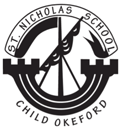Maths
At St Nicholas Primary School, we are committed to raising the standards of learning and teaching of mathematics.
We aim to:
- Meet the statutory requirements of the New National Curriculum 2014;
- Develop fluency in basic number concepts;
- Develop positive attitudes towards mathematics and lifelong learning;
- Develop an ability in the children to choose and explain appropriate methods or strategies for their calculations and when solving real-life problems;
- Develop ability to think clearly and logically with independence of thought and flexibility of mind;
- Promote enjoyment, enthusiasm and motivation for learning through practical activity, exploration and discussion;
- Promote confidence and competence with numbers and the number system;
- Develop the ability to solve problems in a logical way through decision-making and reasoning in a range of contexts;
- Make children aware of the patterns and relationships in the structure of mathematics;
- Demonstrate the importance of mathematics in everyday life and its links with other areas of the curriculum.
Learning and Teaching
The school uses a variety of teaching styles to cater for the range of learning styles of pupils in mathematics lessons. We do this through a daily lesson that has a high proportion of whole-class and group-direct teaching as well as paired and individual work. During these lessons we encourage children to ask as well as answer mathematical questions. They have the opportunity to use a wide range of vocabulary and resources to support their learning.
The children experience a mastery based curriculum through the use of the Power Maths scheme. In each year group a core group of ideas and skills is taught to all children. When they have fully grasped this core knowledge, they are said to have mastered the content for that year group. To challenge the children further they are given increasingly complex problems which require them to apply their learning and deepen their understanding.
The lesson begins with a Power Up or Flash back fluency task to sustain prior learning, consolidate number facts and establish the lesson’s confident, can-do tone.
Next, children share, explore and learn from a Discover problem, presented with some focused questions to guide their thinking.
After the Discover stage, children discuss their learning in a Share activity. During this whole-class, interactive learning phase, children share their thinking and look for the best ways to solve the problem.
The lesson then moves into a Think Together section. It begins with a teacher-guided question followed by a problem for children to solve in collaboration with a partner, and finally an independent question. It develops the concrete problem through the pictorial and abstract stages and there is clear progression within each lesson. The online guide gives fantastic scaffolding here.”
In the Practice section, children use the cleverly devised Practice Books to apply and rehearse what they’ve learned. There’s always an ‘Even Deeper’ challenge question that links to other maths areas, too. Not every child will get to this point in every lesson but it’s great to have it readily available to further learners’ thinking.”
Finally, a Reflect section brings each lesson to a conclusion. It’s not a traditional plenary: it involves everyone looking back on what they feel they’ve each learned, and it’s a great way of helping each child to understand and consolidate their learning.
